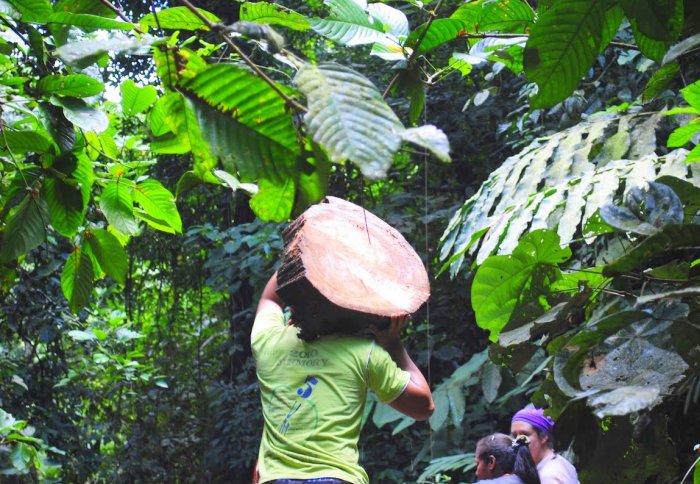Partially logged rainforests could be emitting more carbon than assumed

Measuring dead wood in Borneo. Photo: Marion Pfeifer
Global carbon emissions from forests could have been underestimated because calculations have not fully accounted for the dead wood from logging.
Living trees take in carbon dioxide whereas dead and decaying ones release it. Understanding the proportion of both is important for determining whether a large area of forest is a source of carbon dioxide, or a ‘sink’ that helps to absorb carbon dioxide from the atmosphere.
Forestry, agriculture and land-use changes account for nearly 25 per cent of global greenhouse gas emissions, second only to the energy sector. New research led by Imperial College London on partially-logged tropical rainforests suggests that these forests are probably emitting more carbon than assumed, because they contain a high proportion of dead wood. The study, published in Environmental Research Letters, reveals that in these forests dead wood can make up to 64 per cent of the biomass, the biological material found above ground.
That such logged forests are not properly accounted for in carbon calculations is a significant factor. It means that a large proportion of forests worldwide are less of a sink and more of a source.
– Dr Marion Pfeifer
In untouched forests, dead wood is created through natural processes and makes up less than 20 per cent of the total aboveground biomass. Previously, when estimating the carbon emissions from logged tropical rainforests, researchers have assumed that when live trees are cut down and moved out of the forest, the amount of dead wood is reduced proportionately.
However, the new research paints a clearer picture of the situation in selectively-logged forests where only high-value trees are removed. It shows that because selective logging leaves behind significant damage and tree debris, dead wood actually accounts for up to 64 per cent of the total aboveground biomass.
“I was surprised by how much of the biomass dead wood accounted for in badly logged forests,” said lead author Dr Marion Pfeifer from the Department of Life Sciences at Imperial. “That such logged forests are not properly accounted for in carbon calculations is a significant factor. It means that a large proportion of forests worldwide are less of a sink and more of a source, especially immediately following logging, as carbon dioxide is released from the dead wood during decomposition.”
Selective logging is a growing trend in global forestry. “Selectively-logged tropical forests now make up about 30 per cent of rainforests worldwide. This means such global calculations are wrong at least 30 per cent of the time,” said Dr Pfeifer.
the largest ecological experiments on the planet
The researchers surveyed a large area in the Stability of Altered Forest Ecosystems (SAFE) site, a region of rainforest in Malaysian Borneo. One of the largest ecological experiments on the planet, SAFE takes advantage of the conversion of the region to oil palm plantation to assess the impact of change on the local ecosystems.
Dr Pfeifer and her colleagues assessed the deadwood contributions across a ‘disturbance gradient’ – a range of landscapes including pristine forest, logged forests of increasing severity, and oil palm plantation.
“This large and diverse landscape study provides a lot of field data backing up our research. We are confident in our conclusions,” said Dr Pfeifer. “However, more work needs to be done to apply the results to carbon emissions calculations, such as determining how fast the dead wood is decomposing.”
-
'Deadwood biomass: an underestimated carbon stock in degraded tropical forests?' by Pfeifer et al. is published in Environmental Research Letters.
Article text (excluding photos or graphics) © Imperial College London.
Photos and graphics subject to third party copyright used with permission or © Imperial College London.
Reporter
Hayley Dunning
Communications Division